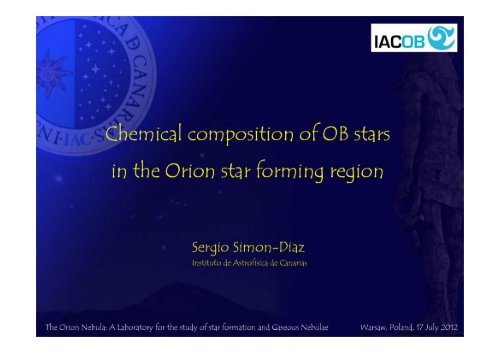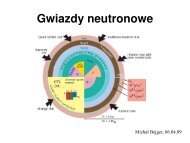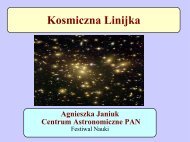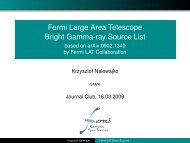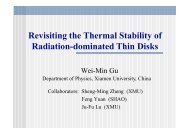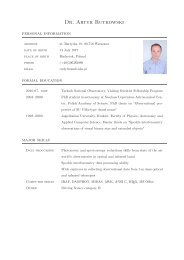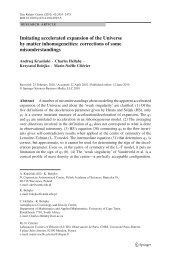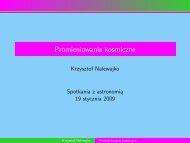download - Users' Pages
download - Users' Pages
download - Users' Pages
You also want an ePaper? Increase the reach of your titles
YUMPU automatically turns print PDFs into web optimized ePapers that Google loves.
The Orion Nebula (M42)<br />
Chemical composition of M42: Traditionally considered<br />
the standard reference for the present-day chemical<br />
composition of the solar neighbourhood.<br />
Caveats CEL/ORL discrepancy, icf’s, dust depletion<br />
M42, a small piece in a more general complex:<br />
The Orion complex
The Orion complex<br />
Orion molecular cloud (OMC) + Ori OB1 association<br />
(One of) the most massive active star-forming regions in<br />
the solar vicinity: The Orion star forming region<br />
The Orion OB1 association<br />
Blaauw (1964): Four subgroups with different ages and<br />
location in the sky<br />
Brown et al. (1994):<br />
Ia: 380(90) pc ~ 11 Myr<br />
Ib: 360(70) pc ~ 2 Myr Horsehead nebula<br />
Ic: 400(90) pc ~ 5 Myr<br />
Id: 400(50) pc < 1 Myr Orion nebula (M42)<br />
+ observational evidence of type-II SNe events<br />
(Goudis 1982 and references therein)<br />
Example of a Galactic site with sequential/triggered<br />
star formation
Why is interesting to investigate<br />
The chemical composition of OB stars in the Orion star forming region<br />
(in the context of this conference)<br />
Photospheres of OB type main sequence stars keep the<br />
same chemical composition as the local ISM from which<br />
they were born<br />
OB stars (actually, low vsini early B-type): An alternative<br />
tool to investigate the present-day chemical composition<br />
of the Galactic region where they are located<br />
Direct comparison* with the abundances derived from<br />
the study of the Orion nebula (same Galactic site)<br />
* Be aware of dust depletion and the possible<br />
enrichment of the youngest stars by type-II SNe ejecta<br />
(O, Si ...) in a sequential star formation scenario
The chemical composition of OB stars in the Orion star forming region<br />
Looking for good candidates ...<br />
B1 V B1.5 V<br />
O9 V B0.5 V B1.5 V B2 V<br />
SpT > O9 V SpT < B2 V<br />
vsini < 30 km/s<br />
30 < vsini < 60 km/s<br />
vsini > 60 km/s<br />
Best candidates:<br />
Main sequence<br />
early-B stars (B0 – B2)<br />
with low vsini (< 50 km/s)<br />
Diagnostic lines<br />
C III + C II<br />
(N III) + N II<br />
O II (+ O I)<br />
Ne I + Ne II<br />
Ar II<br />
S II + S III<br />
Si IV + Si III + Si II<br />
Mg II<br />
Fe II + Fe III<br />
H I + He I + He II<br />
Ideal !!<br />
Still good !<br />
More difficult
Why is interesting to investigate<br />
The chemical composition of early B MS stars in the Orion star forming region<br />
(in a more general context)<br />
O’Dell (yesterday): One must understand the best example<br />
of a class of objects before generalizing about more distant<br />
objects<br />
Ori OB1 contains a large number of bright, low vsini, early<br />
B-type stars (covering the full range B0-B2)<br />
we can test our codes, methods, and atomic data with<br />
a set of high quality spectra<br />
+ identification of problematic/best diagnostic lines<br />
+ identification of possible biases and systematics<br />
a reference for abundance studies of more distant stars<br />
(and/or larger vsini)<br />
Ideal !! <br />
Still good ! <br />
More difficult <br />
SNR > 150<br />
100 < SNR < 150 km/s<br />
SNR < 100 km/s
Why is interesting to investigate<br />
The chemical composition of early B MS stars in the Orion star forming region<br />
(in a more general context)<br />
Put more constraints to the present-day<br />
chemical composition* of the solar vicinity,<br />
including elements which cannot be easily<br />
studied from HII regions (e.g. Si, Mg)<br />
* No dust depletion !!
Chemical abundance studies of early-B stars in Orion OB1<br />
A quick summary of what can be found in the literature<br />
O<br />
Si<br />
C<br />
N<br />
Fe<br />
Mg<br />
Ne<br />
Ar<br />
S<br />
Cunha & Lambert (1994)<br />
LTE<br />
8.73 ± 0.13<br />
7.36 ± 0.14<br />
8.35 ± 0.06<br />
7.79 ± 0.11<br />
7.47 ± 0.10<br />
NLTE<br />
8.72 ± 0.13<br />
7.14 ± 0.13<br />
8.40 ± 0.11<br />
7.76 ± 0.13<br />
18 stars (B0-B2) : Ia,b,c,d<br />
Cunha et al. (2006)<br />
Lanz et al. (2008)<br />
Daflon et al. (2009)<br />
8.11 ± 0.04<br />
6.66 ± 0.06<br />
7.15 ± 0.05<br />
11 stars (B1-B1.5): Ia,b,c<br />
Simón-Díaz<br />
(2010)<br />
8.73 ± 0.04<br />
7.51 ± 0.03<br />
• Different codes, different strategies (will talk about this in a few minutes ...)<br />
• Not many differences between “old” and “new” mean values (except for Si)<br />
• The associated dispersions have drastically decresed in many cases<br />
Nieva & Simón-Diaz<br />
(2011)<br />
8.77 ± 0.03<br />
7.50 ± 0.06<br />
8.35 ± 0.03<br />
7.82 ± 0.07<br />
7.52 ± 0.02<br />
7.57 ± 0.06<br />
8.09 ± 0.05<br />
13 stars (B0–B2): Ia,b,c,d
The chemical composition of early-B type stars in Ori OB1 (Cunha & Lambert 1994)
The chemical composition of early-B type stars in Ori OB1 (Cunha & Lambert 1994)<br />
The higher values of the O abundances are found<br />
for stars in the youngest groups (Id and some Ic)<br />
O and Si abundances are correlated<br />
Coherent with a scenario of induced star formation in which<br />
the new generation of stars are formed from insterstellar<br />
material contaminated by type-II SN ejecta (O, Si, ...)
(Comparison with the O abundance content in the Orion nebula)<br />
Oxygen abundance in M42 (Esteban et al. 2004)<br />
• Preferred diagnostic lines: ORL<br />
• O depleted on to dust grains by a factor of 0.08 dex<br />
(Esteban et al. 1998)<br />
ORL + DUST
The chemical composition of early-B type stars in Ori OB1 (Cunha & Lambert 1994)<br />
The higher values of the O abundances are found<br />
for stars in the youngest groups (Id and some Ic)<br />
O and Si abundances are correlated<br />
Coherent with a scenario of induced star formation in which<br />
the new generation of stars are formed from insterstellar<br />
material contaminated by type-II SN ejecta (O, Si, ...)
The chemical composition of early-B type stars in Ori OB1 (Simón-Díaz 2010)<br />
Homogeneous set of O and Si abundances (scatter < intrinsic uncertainties)<br />
No clear signatures of contamination of the last generation<br />
of stars by SNe type-II ejecta
How to perform a stellar abundance analysis: a general overview<br />
GRID OF MODELS<br />
OBSERVED SPECTRUM<br />
PHOTOMETRIC DATA<br />
STELLAR PARAMETER<br />
DETERMINATION<br />
T eff , logg, ε(He), (wind param.)<br />
• Synthetic line profiles<br />
• EWs<br />
• Global SED<br />
Observed line profiles and EWs<br />
Stellar atmosphere model for<br />
the studied star<br />
T eff , logg, ...<br />
STELLAR ATMOSPHERE CODE<br />
T eff , logg, ε(He), Z, (wind param.)<br />
+ ε(X i ), ζ t<br />
ε(X i ), ζ t<br />
ABUNDANCE<br />
ANALYSIS
How to perform a stellar abundance analysis: a general overview<br />
Stellar atmosphere code: from the stellar parameters to the synthetic lines<br />
STELLAR ATMOSPHERE CODE<br />
Stellar atmosphere model + Line formation code<br />
Stellar atm. structure: Te(τ), Ne(τ)<br />
Global SED<br />
-- LTE/NLTE, line blanketing --<br />
Level populations: N ij (τ)<br />
Line profiles + EWs<br />
-- LTE/NLTE --<br />
• ATLAS (Kurucz)<br />
• TLUSTY (Hubeny & Lanz)<br />
• CMFGEN (Hillier)<br />
• FASTWIND (Puls et al.)<br />
• DETAIL/SURFACE<br />
(Buttler & Giddings)
How to perform a stellar abundance analysis: a general overview<br />
A VERY important step: stellar parameter determination<br />
Use of photometric calibrations vs. Self-consistent spectroscopic approach<br />
e.g. Lester, Gray & Kurucz (1986)<br />
[c 1 ] = c 1 – 0.20 (b-y) = f(T eff , logg)<br />
Based on Kurucz’s (1979) models<br />
T eff , logg, ... are determined by using<br />
synthetic lines resulting from the same<br />
stellar atmosphere code that will be<br />
used for the abundance analysis
How to perform a stellar abundance analysis: a general overview<br />
Abundance determination: the curve of growth method<br />
For a fixed set of stellar parameters<br />
T eff , logg, ε(He), (wind param.)<br />
i.e. a given atmosphere structure<br />
Grid of EWs of diagnostic lines<br />
(line formation code)<br />
for different [ε(X), ζ t ] – pairs
What is new/different between CL94 and SD10 ?<br />
1) Stellar atmosphere codes<br />
Cunha & Lambert (1994): ATLAS6 (plane-parallel) LTE blanketed models<br />
+ WIDTH6 LTE line formation computations<br />
Gold (plane-parallel) LTE slighly blanketed models<br />
+ NLTE line formation computations<br />
Simón-Díaz (2010): Spherical NLTE line blanketed models<br />
+ NLTE line formation computations (FASTWIND)<br />
2) Method to establish the stellar parameters<br />
Cunha & Lambert (1994): Photometric calibrations + Hγ<br />
Simón-Díaz (2010): Self consistent spectroscopic approach (H, He I/II, Si II/III/IV)<br />
3) Different spectroscopic dataset + O and Si lines used in the analysis
A new analysis of the B-type stars in Ori OB1 (Simón-Díaz 2010)<br />
Spectroscopic approach: Si II-IV lines as T eff indicators in B0-B2 V stars<br />
Depending of the star, different Si line<br />
ratios must be used as T eff indicators:<br />
Si IV/III, Si II/III
A new analysis of the B-type stars in Ori OB1 (Simón-Díaz 2010)<br />
Stellar parameter determination: spectroscopic approach<br />
For the hotter objects: Si IV /Si III ionization balance ...<br />
and the H Balmer lines<br />
log g = 4.2 log g = 4.3 log g = 4.4<br />
T eff =26000 ± 400 K T eff =26200 ± 400 K T eff =26500 ± 400 K
A new analysis of the B-type stars in Ori OB1 (Simón-Díaz 2010)<br />
Stellar parameter determination: spectroscopic approach<br />
... also the He I-II ionization equilibrium (if Teff > 29000 K)<br />
HD 36512 (B0 V)<br />
H-Si analysis<br />
logg = 4.2<br />
T eff = 33700 K<br />
H-He analysis<br />
logg = 4.2<br />
T eff = 34000 K
A new analysis of the B-type stars in Ori OB1 (Simón-Díaz 2010)<br />
Stellar parameter determination: spectroscopic approach<br />
For the cooler objects: Si II /Si III ionization balance ... and the H Balmer lines
A new analysis of the B-type stars in Ori OB1 (Simón-Díaz 2010)<br />
Silicon abundance determination + fine-tuning of stellar parameters (curve of growth)<br />
• For a given pair (Teff, logg), 2 free<br />
parameters: (ξ t , ε(Si))
A new analysis of the B-type stars in Ori OB1 (Simón-Díaz 2010)<br />
Silicon abundance determination + fine-tuning of stellar parameters (curve of growth)<br />
• For a given pair (Teff, logg), 2 free<br />
parameters: (ξ t , ε(Si))<br />
• Actually, the four parameters are<br />
determined at the same time
A new analysis of the B-type stars in Ori OB1 (Simón-Díaz 2010)<br />
Silicon abundance determination + fine-tuning of stellar parameters (curve of growth)<br />
• For a given pair (Teff, logg), 2 free<br />
parameters: (ξ t , ε(Si))<br />
• Actually, the four parameters are<br />
determined at the same time<br />
• Detailed analysis by multiplets<br />
Identification of problematic lines<br />
(blends, atomic model ...)
A new analysis of the B-type stars in Ori OB1 (Simón-Díaz 2010)<br />
Silicon abundance determination + fine-tuning of stellar parameters (curve of growth)<br />
• For a given pair (Teff, logg), 2 free<br />
parameters: (ξ t , ε(Si))<br />
• Actually, the four parameters are<br />
determined at the same time<br />
• Detailed analysis by multiplets<br />
Identification of problematic lines<br />
(blends, atomic model ...)
A new analysis of the B-type stars in Ori OB1 (Simón-Díaz 2010)<br />
Results from the analysis: (I) Stellar parameters and Si abundances<br />
Si IV 4116<br />
Si III 4552<br />
Si II 4130<br />
Si III 4552<br />
Si II 6371<br />
Si III 4552<br />
Total uncertainty ∼ ± 0.07 – 0.09 dex
A new analysis of the B-type stars in Ori OB1 (Simón-Díaz 2010)<br />
Oxygen abundance analysis: method and uncertainties<br />
Method: similar to Si, but only with O II lines<br />
1) Uncertainty due to EW measurement<br />
2) Uncertainty due to microturbulence determination<br />
3) Uncertainty due to line dispersion<br />
4) Uncertainty due to stellar parameter determination<br />
HD36512 logg = 4.2 T eff = 33, 34, 35 kK HD35299 logg = 4.2 T eff = 23, 24, 25 kK
A new analysis of the B-type stars in Ori OB1 (Simón-Díaz 2010)<br />
Results from the analysis: (II) O abundances<br />
Total uncertainty ∼ ± 0.08 – 0.12 dex
A new analysis of the B-type stars in Ori OB1 (Simón-Díaz 2010)<br />
Comparison with results from CL94: stellar parameters<br />
1) Important discrepancies in the derived stellar parameters<br />
HD36960 (3)
A new analysis of the B-type stars in Ori OB1 (Simón-Díaz 2010)<br />
Comparison with results from CL94: O and Si abundances<br />
1) Important discrepancies in the derived stellar parameters<br />
2) O and Si abundances are more homogeneous than previously<br />
estimated !!<br />
3) Dispersion of abundances is smaller than intrinsic uncertainties<br />
1<br />
11<br />
4
A new analysis of the B-type stars in Ori OB1 (Simón-Díaz 2010)<br />
Summary of results regarding oxygen<br />
• Homogeneous set of oxygen abundances<br />
• Scatter (0.04) < intrinsic uncertainties (0.10)<br />
• Newly formed stars contaminated by type-II SNe ejecta?<br />
• Same mean value and scatter as in the rest of the Solar neighbourhood<br />
Orion OB1<br />
Simón-Díaz (2010)<br />
ε(O) = 8.73 ± 0.04<br />
Solar neighbourhood<br />
Przybilla et al (2008)<br />
Nieva & Przybilla (2012)<br />
ε(O) = 8.76 ± 0.05
A new analysis of the B-type stars in Ori OB1 (Simón-Díaz 2010)<br />
Summary of results regarding silicon<br />
• Homogeneous set of silicon abundances<br />
• Scatter (0.03) < intrinsic uncertainties (0.08)<br />
• Very good agreement with P08 and AGS07<br />
Si (B-type stars) not subsolar any more !!<br />
Orion OB1<br />
Simón-Díaz (2010)<br />
ε(Si) = 7.51 ± 0.03<br />
Solar neighbourhood<br />
Przybilla et al (2008)<br />
Nieva & Przybilla (2012)<br />
ε(Si) = 7.50 ± 0.06<br />
CL94 – Cunha & Lambert (1994)<br />
P08 – Przybilla et al. (2008)<br />
G98 – Grevesse & Sauval (1998)<br />
AGS07 – Asplund et al. (2007)
The chemical composition of early-B type stars in Ori OB1 (Cunha & Lambert 1994)<br />
5. Conclusions<br />
[...] O and Si, on the other hand, exhibit larger abundance variations<br />
than can be accounted for by the identifiable errors and, hence, either<br />
the errors have been incorrectly characterized for Si and O, or the<br />
abundance variations are real. [...]
A new analysis of the B-type stars in Ori OB1 (Nieva & Simón-Díaz 2011)<br />
What about the other abundances derived by CL94?<br />
Simón-Díaz (2010)<br />
• O and Si abundances<br />
• FASTWIND (NLTE)<br />
• Spectroscopic approach: H, Si II/III/IV, O II<br />
• Curve of growth<br />
Nieva & Simón-Díaz (2011)<br />
• C, N, O, Ne, Si, Mg, Fe abundances<br />
• TLAS (LTE) +DETAIL/SURFACE (NLTE)<br />
• Spectroscopic approach: H, C II/III, O I/II, Ne I/II,<br />
Si III/IV, Fe II/III, N II<br />
• Spectral synthesis
A new analysis of the B-type stars in Ori OB1 (Nieva & Simón-Díaz 2011)<br />
What about the other abundances derived by CL94?<br />
O<br />
Si<br />
C<br />
N<br />
Fe<br />
Mg<br />
Ne<br />
LTE<br />
8.73 ± 0.13<br />
7.36 ± 0.14<br />
8.35 ± 0.06<br />
7.79 ± 0.11<br />
7.47 ± 0.10<br />
CL94<br />
NLTE<br />
8.72 ± 0.13<br />
7.14 ± 0.13<br />
8.40 ± 0.11<br />
7.76 ± 0.13<br />
NS-D11<br />
8.77 ± 0.03<br />
7.50 ± 0.06<br />
8.35 ± 0.03<br />
7.82 ± 0.07<br />
7.52 ± 0.02<br />
7.57 ± 0.06<br />
8.09 ± 0.05<br />
• Not very different mean values (except for Si)<br />
• BUT smaller scatter
Chemical abundance studies of early-B stars in Orion OB1<br />
Neon (Cunha et al. 2006) & Argon (Lanz et al. 2008)<br />
A(Ne)* = 8.11 +/- 0.04 dex (Used ions: Ne I)<br />
A(Ar)* = 6.66 +/- 0.06 dex (Used ions: Ar II)<br />
• Stellar parameters (Teff, logg) adopted from CL94<br />
• TLUSTY/SYNSPECT NLTE atmospheres + NLTE line formation<br />
Sulfur (Daflon et al. 2009)<br />
A(S)* = 7.15 +/- 0.05 dex (Used ions: S II/III)<br />
• Stellar parameters (Teff, logg) adopted from CL94 + fine-tuning if A(SIII-SII) > 0.15 dex<br />
• ATLAS LTE blanketed atmospheres + DETAIL/SURFACE NLTE<br />
* 11 B-type stars from the original sample by CL92 (Ia, Ib, Ic)<br />
Excluded stars: HD36430 (B2V), HD36512 (B0V),<br />
HD36629 (B2V), HD37481 (B1.5 IV),<br />
HD37020 (B0.5V), HD37023 (SB2), HD37042 (B0.7 V)
Conclusions<br />
- Recent accurate abundance analyses of B-type stars in the OriOB1 association have shown<br />
that the dispersion of O and Si abundances between stars in the various subgroups found in<br />
previous analyses is a spurious result and the consequence of a bad characterization of the<br />
abundance errors propagated from the uncertainties in the stellar parameter determination.<br />
- The present day abundances of B-type stars in Ori OB1 are compatible at similar precision<br />
with other B-type stars in the Solar neighbourhood (Nieva & Przybilla 2012) and also with<br />
the last revision of abundances in the Sun (Asplund et al. 2009)
ADDENDUM<br />
Orion OB1: B-type stars vs. nebular (M42) abundances<br />
(Simón-Díaz & Stasinska 2011 + extra information)
Orion OB1: B-type stars vs nebular (M42) abundances<br />
Elem.<br />
O<br />
O (g+d)<br />
C<br />
N<br />
Ne<br />
S<br />
Ar<br />
B-type stars<br />
(OriOB1)<br />
8.74 ± 0.04 †<br />
8.35 ± 0.03 †<br />
7.82 ± 0.07 †<br />
8.09 ± 0.05 †<br />
7.15 ± 0.05 ††<br />
6.66 ± 0.06 †††<br />
CEL<br />
8.51 ± 0.03<br />
8.64 – 8.67<br />
---<br />
7.65 ± 0.09<br />
7.78 ± 0.07<br />
7.06 ± 0.04<br />
6.50 ± 0.05<br />
M42 (E02)<br />
† Simón-Díaz (2010) + Nieva & Simón-Díaz (2011)<br />
†† Daflon et al. (2009)<br />
††† Lanz et al. (2008)<br />
8.42 ± 0.02<br />
8.16 ± 0.2<br />
7.92 ± 0.09 (b)<br />
6.87 ± 0.05 (b)<br />
(a) Classical icf<br />
(b) icf own model<br />
E02: Esteban et al. (2002)<br />
S-DS11: Simón-Díaz & Stasinska (2011) Rubin et al. (2010): IR[NeII] + IR[NeIII] = 8.01 ± 0.01 dex<br />
ORL<br />
8.63 ± 0.03<br />
8.72 – 8.77<br />
---<br />
---<br />
---<br />
CEL<br />
8.52 ± 0.01<br />
8.65 - 8.68<br />
---<br />
7.68 ± 0.10 (a)<br />
7.84 ± 0.03 (a)<br />
8.05 ± 0.03 (b)<br />
6.39 ± 0.03 (b)<br />
M42 (S-DS11)<br />
ORL<br />
8.65 ± 0.03<br />
8.74 – 8.79<br />
8.37 ± 0.03<br />
---<br />
8.03 ± 0.26 (a)<br />
8.25 ± 0.35 (b)<br />
---<br />
---
Orion OB1: B-type stars vs nebular (M42) abundances (Simón-Díaz & Stasinska 2011)<br />
Taking care of O depletion onto dust grains... (see also Esteban et al. 1998)<br />
Draine (2003)<br />
O<br />
CEL<br />
RL<br />
Elem.<br />
Mg<br />
O (dust) = 125 – 135 ppM (± 10 ppm)<br />
Stars<br />
8.74 ± 0.04<br />
Gas<br />
8.52 ± 0.01<br />
8.65 ± 0.03<br />
Dust correction (O) = 0.09 – 0.16 dex<br />
Si<br />
Fe<br />
Gas + dust<br />
8.65 – 8.68<br />
8.74 – 8.79<br />
Stars<br />
7.51 ± 0.03 †<br />
7.57 ± 0.06 †<br />
7.50 ± 0.04 †<br />
6.50 ± 0.25<br />
6.50 ::<br />
6.0 ± 0.3<br />
Gas phase (M42)<br />
Rubin et al. (1993)<br />
Baldwin et al. 1991<br />
Rodríguez & Rubin (2005)


